Family : Hippopotamidae

Text © DrSc Giuliano Russini – Biologist Zoologist

English translation by Mario Beltramini
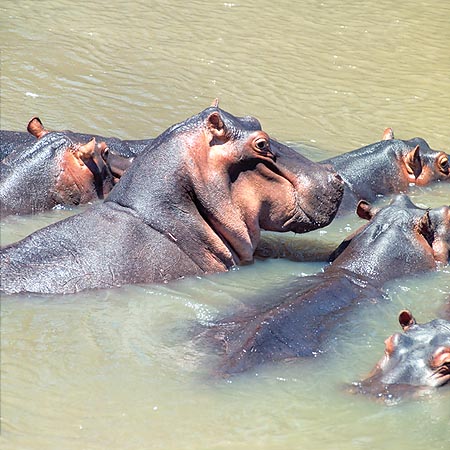
Hippos are deemed to stand among the most aggressive herbivores © Mazza
The Hippopotamus (Hippopotamus amphibius Linnaeus, 1758), from the ancient Greek “ιπποπόταμος”: river horse, is a big quadruped, placentate, herbivorous, mammal, living nowadays in the humid regions of South Saharan Africa in a habitat formed by ponds, big bodies of water, swamps and rivers, better if surrounded by bed of reeds and meadows, where it gets its nourishment from the vegetables.
Of enormous size, it forms, together with the rhinoceroses and the elephants the group of the biggest terrestrial mammals, called pachyderms.
It is one of the two surviving species of the family of the Hippopotamidae . We shall treat about the other, the Pygmy Hippopotamus (Choreopsis liberiensis), which even more retains the characters of the extinguished ancestors, in the relevant article.
All of them, males, females and progeny, spend almost all the day completely immersed in the water. Like crocodiles and alligators, they surface with their ears and the big nostrils placed on the front side of the face, which often reveal the position of the animal with puffs and bubbles. The great eyeballs, covered by a big lid, stand conspicuously on the lateral surface of the skull and are therefore called exophtalmic. The nourishing activity of pasturage is specifically nocturnal.
From the capacity it has to live both on the mainland, fully breathing the atmospheric air, and underwater, holding its breath, comes the name of amphibius. Incredibly, it is able, without any effort, to remain immersed for hours and hours. During the heat season, the coupling takes place under the water, and under the water happens the delivery and the nursing of the offspring. At times, it can even sleep, emerging when necessary for breathing in a status of partial waking. This thanks to the fact that the hippopotamuses have strong voluntary contracting muscles on the nostrils and the ears, which can close hermetically. Once the big lungs are full of air, they can live peacefully in immersion. We must remark also that, in spite of being very swift under water, as a fact, the hippopotamuses do not swim, but tend to walk on the bottom.
Paleozoologic studies have permitted to verify both the origin of the ancestral predecessors of these mammals, as well as their zoogeographic distribution and their time of appearance on the planet. In the mean time, a revaluation of their taxonomic systematics is going on, in concomitance with the discovery that the order of the Artiodactyls (Artiodactyla) has a common origin with that of the Cetaceans (Cetacea), so much that nowadays they talk of polyphyletic order of the Cetartiodactyls (Cetartiodactyla). The hippopotamuses have, in short, more affinities with the whales than those they have with the other artiodactyls.
This assertion, which might leave puzzled, would seem to be confirmed by the contemporaneousness of zoo-paleontologic, anatomic-comparative and genetic studies. From these studies, they hypothesize that about 60 million of years ago (Tertiary, Cenozoic), both the hippopotamuses and the whales had a common amphibian ancestor, till now unknown, from which, during the following 5 millions of years (55 million of years ago), two phylogenetic branches should have detached. The first early whale Pakicetus , ancestor of the present cetaceans (Odontoceta and Mysticeti), should have originated, and from the second, the Archaeoceti , from which should come the family of the Hippopotamidae .
Furthermore, such studies would lead to think that the hippopotamuses during the Cenozoic, were present in Africa (Madagascar included), but also in Asia and in Europe, in particular in this last continent in those areas where now are England, the islands of Crete and Cyprus. As a matter of fact, they have found in the three aforesaid continents the remains of skeletons of animals representing the more ancient species of hippopotamuses from which directly descend the present two species.
These prehistoric species were the Hippopotamus gorgops which was able to live in much deeper waters than those where do live the present species, and they have found remains of this in Asia (Sri Lanka), present from the Cenozoic till a maximum density in the Pleistocene and Pliocene (about 2-3 million of years ago). On the contrary, until about 12.000 years ago, in the present Great Britain, and the islands of Crete and of Cyprus, was present a species called Hippopotamus minutus , and till 2.000 years ago, in Madagascar, were present the Hippopotamus madagascariensis and the Hippopotamus lemerlei.
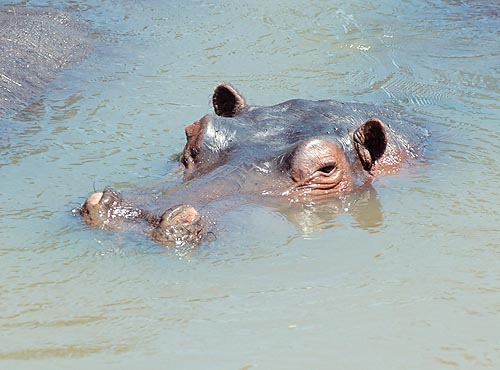
Nostrils, eyes and ears surface, like crocodiles do © Giuseppe Mazza
During the Egyptian civilization (as it comes out from archaeological documents), the hippopotamuses were living in the low valley of the Nile (at that time very fertile) with a very high density of population. The mystery surrounding their style of life, the typical aggressiveness (they are, along with the African Buffalo, the most aggressive herbivores, capable to oblige elephants and the rhinoceroses which invade, for refreshing themselves, their water pond, to run away) and the enormous dimensions united with a full-roundish line, had rendered them worshipped as a divinity, to which were associated powers on the fertility, like what happens still now for the sacred cows for the Indians.
Only the lions are able to attack this splendid animal species, when it is out of water, awkward as it is owing to its clumsy walking, and in the old times the area occupied by the species was, by sure, well wider than nowadays, correlated to different habitat conditions. The disappearance of the hippopotamuses in Europe and Asia, is in fact to be attributed more to too excessive and rapid climatic changes for their physiology and ecology, than to the human being fault, and presently, as said before, the two extant species are endemic to sub-Saharan Africa.
In particular, Hippopotamus amphibius is still present in the Nile valley, but not beyond Khartoum, the capital of Sudan. It is found in RSA and in Swaziland, in the People’s Democratic Republic of Congo, in Chad, in Burundi, where it is often enclosed in protected areas, also because local populations, mostly in the past, did kill them for the meat, with remarkable collapses of the population density, as declared by CITES and IUCN.
Some specimens of the Hippopotamus amphibius have ventured as far as the Mafia Island (where they are still present), crossing an extent of sea of about 30 km, characterized by deep waters, separated by the rest of the African continent by Tanzania.
The Choeropsis liberiensis (pygmy hippopotamus), on the contrary, lives in the western sub-Saharan Africa, in particular in Liberia, Ivory Coast, Sierra Leone and Guinea.
In the Hippopotamus amphibius the skin is glabrous, hair are present as vibrissae only on the muzzle and the hypodermic coating is characterized by the presence of an even 5 cm thick panniculus adiposus, which protects the internal organs and allows the animal, when in inland regions, to reach even an altitude of 2.000 metres, as it bears well temperatures of 0°C, which are frequent in the dry season.
It looks like that there is a sort of collaboration between the Hippopotamus amphibius and the elephants (Loxodonta africana), of which the zoologist biologists suspected the existence, during the seventies, but its reality is nowadays more verified by studies effected on these species present in nature reserves. This collaboration should represent real and proper biologic cycles of interaction between different animal and vegetal species. Such cooperation exploits, in fact, the vital cycles of the vegetal species of which these two species of pachyderms nourish and which would influence the densities of their populations.
It seems that (without invading the relevant reciprocal areas in order to avoid clashes), the elephants tend, in the zones frequented by the hippopotamuses, with swamps, watercourses, or bodies of still water, to nourish of trees with long vital cycle and long growth phases, leaving in this way ample room to the grass, with the formation of meadows able to aliment a great quantity of hippopotamuses. On the contrary, when there are no elephants, or, for some reason, the big foliage trees of which they nourish are in excess, the room for the pasturages reduces, the number of hippopotamuses diminishes and they are compelled to migrate.
An almost unique characteristic of these animals is the tendency to sprinkle the areas where they live (not only the waters where they bathe, but also the surrounding green zones and the paths they create for reaching the water bodies), with their excrements in huge quantity.
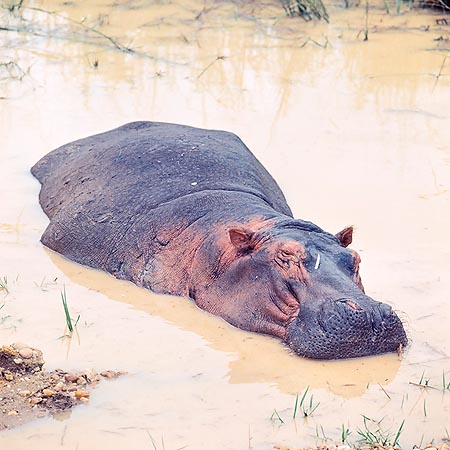
The hippopotamus grazes mainly during the night © Giuseppe Mazza
This is a contribution to the wellbeing of the whole ecosystem, with an enrichment of its flora and fauna, as the excrements guarantee nutritional principles for the growth of vegetal species, both terrestrial and aquatic, pedo-fauna, various species of fish, such as Cichlids (Cichlidae), Carpoids (Carpoidae), etc., and, indirectly, birds (Cattle Egrets, Squacco Herons, Oxpeckers), various ungulates, even aquatic reptilians such as pond turtles and small crocodiles, which will eat the numerous fish present in the water bodies.
A said before, the hippopotamuses are, along with the African Buffalo, between the most aggressive herbivores, behaviour they have not only for defending their progeny, but also their territory, or because frightened by the approach of man or other dangerous animals.
Together with the lions (Panthera leo) and the elephants (Loxodonta Africana), they are one of the main reasons of deaths caused by animals in Africa, especially for the difficulty to sight them in water, where they can easily capsize a boat, crush the persons with their body, or tear them into pieces with their triangular section canines, long even one metre and weighing even 6 kg.
Theoretically, like rhinoceroses and elephants, also the hippopotamuses do not have natural foes.
The offspring can be killed by lions, groups of hyenas and crocodiles, and there have been instances of crocodiles (Crocodylus niloticus) which have killed even adult specimens thanks to their powerful bite, and of crowds of lions which have done the same thing. In some areas, this practice seems to happen even frequently. In other cases, a single lion has attacked adult hippopotamuses from the back. These attacks can be even fatal for the predator, and often, the assailants are crushed or torn into pieces by the enormous canines of the herbivore. During the sixties, a team of zoologists has documented the killing of a 2 m long specimen of a Mako shark (Isurus oxyrinchus – a particularly aggressive and dangerous species), by a male of Hippopotamus amphibius , by the St. Lucia estuary, in South Africa, proving its spectacular strength, the courage and the aggressiveness characterizing these animals.
Zoogeography
Endemic of sub-Saharan Africa, they are distributed over several African regions: Sudan, RSA and Swaziland, People’s Democratic Republic of Congo, Chad, Burundi.
Habitat-Ecology
They live in areas where are water bodies, ponds, rivers, lakes, which they utilize constantly during the day for bathing, better if surrounded by beds of reeds and meadows where they can graze. In the zone neighbouring these bodies, they create a path for reaching them, which is also utilized by other animals for going to drink, at least till when they are allowed to do so.
Morphophysiology
Mammals of enormous size, quadruped, placentate herbivores, they can reach a height of about 1,60 m at the withers and weigh from 2,0 to 4,6 t. The males are bigger than the females. They have an elongated skull ending with a hairy, round, muzzle. A pair of big nostrils, placed frontally, small but complete ears, placed on the sides of the skull, big nictitating eyes, suitable for a good under water vision. Robust body, cylindrical, four heavy limbs, each one with four palmate toes with a nail on each one. They have a not much developed hearing, however they catch the sounds by means of the vibrations, which in the water, pass through the body. The eyesight is good, in any case suitable for allowing an underwater life and the sense of smell is developed.
They are heterodont (teeth of different dimensions and morphology), with a number varying, in the adults, from 36 to 40, as the incisors can vary from 4 to 6. The inferior canines are at continuous growth and have an irregular section, can reach a length of one metre and weigh up to 6 kg, and they are utilized as a defensive weapon. They are glabrous, have only hair on the muzzle which act as vibrissae (tactile hair). The stratum corneum is thin on the epidermis, there are no sebaceous glands, for this reason they lose, for evaporation, a lot of water, which they recover spending most of their time in immersion.
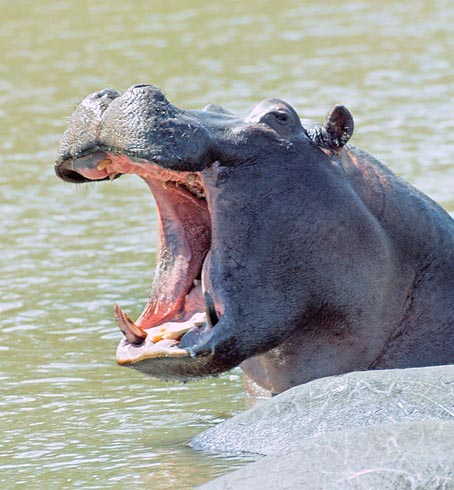
Wide open fauces are a clear menacing signal © Giuseppe Mazza
On the skin are present some special epithelial cells which emit a viscous secretion of alkaline nature. This secretion protects the animal from the dehydration when out from the water and might have also cicatrizing properties for the animal. Furthermore, it reflects the light in such a way that the animal acquires a red-violaceous coloration , like if it would be oozing blood.
They live an average of 30-40 years.
They have a short thin terminal tail which has a fundamental importance on the ethologic point of view, as in the fights for the determination of the hierarchical position, an old male defeated by a young pretender, suffers the shame of the removal of the tail, which is the maximum degree of humiliation, obliging the old animal to leave the group and to live alone, so much as to suicide for starvation.
Ethology-Reproductive Biology
The hippopotamuses have a social structure rather complicated and till now not yet clarified. They live in groups, even if some specimens (especially the elders) can have a lonely life. The Pygmy hippopotamus (Choreopsis liberiensis) is by sure conducting a more solitary life than the Hippopotamus amphibius .
In any case, generally, the hippopotamuses of the species amphibius live in more or less numerous groups, the dimension of which depends on the available room and on the type of aquatic zone being exploited, considering that as vital space of the same, the water is utilized as well as the surrounding terrestrial space. The banks of a river can even lodge 33 specimens for 100 m of space, whilst on the shores of a lake in an equivalent area stay usually 8-9 specimens. There is always a big dominating male who, initially, takes possession of the area and establishes the hierarchic order of domination, placing with the back towards the water, evacuating the bowels and urinating by splashes, both the feces and the urine will be sodden with characteristic individual pheromones. The younger males, smell and taste the excrements for recognizing the domination of the hierarch.
Inside the population, sub groups will form, where the dominating male lives always a little far away from the other members, in its own vital space, always alert and keeping under control the territory and the members. Then take form groups with young, but self-sufficient, males and females, whilst a third group is composed by the mothers with the offspring in brooding, not yet weaned.
To the dominant is guaranteed the possibility to get closer to the females, in such a way to be advantaged, during the heat season, for the mating which can happen with more partners. The presence of other young males suitable for coupling, causes furious fights with the dominant for the female in oestrum. Fights which, however, are also frequent for the conquest of the territory and of the superior hierarchic order, by the young present in the same group. Proof of that are the deep scars present on the body of the elder animals. As a matter of fact, the fights engaged for the two aforesaid reasons, involve heavy fights in water, with strong bellows, wheezes and bites utilizing the terrible inferior canines (which are not utilized for eating), and can cause deep wounds, which will cicatrize quickly provided they are not fatal.
A characteristic sign of threat towards the dominant for the group is represented by the wide opening of the fauces, which can reach the 160° of aperture, displaying the canines and emitting aggressive roars. If one of the two contenders, places with the side towards the other, the fight ceases, as such ritual is indicative of a resignation. If, on the contrary, the opening of the mouth continues, the animals will start fighting after short time. Often it happens that a yawn (frequent gesture in these animals) is mistaken as an aggression sign by the dominant, causing the explosion of sudden fights.
The Hippopotamus amphibius , as said before, are herbivorous, and eat grass on the meadows and prairies surrounding the pond or the water body and aquatic plants. Their nutritive activity takes place only after the sunset. When time comes, the number of yawns increases in frequency. It is probably a code with which they tell that “it’s time for dinner”, and then they start moving, looking for the meal, communicating with sounds for indicating the presence or not of food in a certain area; sounds which can cover also 1 km in the water stream.
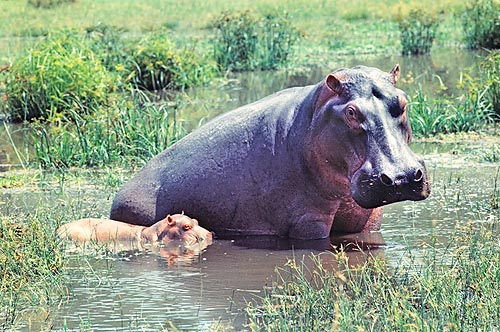
Hippopotamus amphibius with young © Giuseppe Mazza
Every hippopotamus eats about 40 kg of fresh grass per day. After their passage, the pasturages look like well shorn lawns as they cut the blades of grass at the base.
They nourish also of gramineae like the genera Panicum, Urocholora or Cynodon, and, however, the diet varies depending on the region.
Even if they are not ruminants, the gastro enteric system and their physiology are odd under various aspects. The stomach has two diverticula, which slow down the transit of the alimentary bolus towards the intestine, increasing the time of assimilation. The intestine is rich of a flora formed by bacteria and ciliate protozoa able to degrade the cellulose and the hemicellulose allowing these animals to eat a volume of daily food inferior, for instance, than that of the rhinoceroses. We have to keep in mind, however, that they are not ruminants, like the bovines.
The reproductive system of the males is consists in a couple of testicles with a complete functional penis, which, like the rhinoceroses, is oriented to the opposite direction. The males are sexually mature between the 6 and 13 years, the females between the 7 and 15 years.
The heat and mating season does not have a definite period, what has been observed is that the young come always to life during the rain seasons, which means that in the regions where there is just one of them, there will be one delivery per year (for instance in South Africa), in the regions where there are two of such seasons, (eastern Africa) there will be two subsequent deliveries.
The deliveries are single, rarely twins, the female presents a biconcamerate uterus with sindesmocorial placenta, the pregnancy lasts 8 months, the suckling about 12 months, the post-suckling phase is characterized by four months where the female is not sexually receptive (that is, does not go in heat). So, as an average, the childbirths repeat every 24 months. There is a high mortality at the delivery mainly in the primiparae (to the first delivery) which decreases in the pluriparae, and also in juvenile phase.
The female is characterized by an ovulation phase lasting even three days. The coupling, the delivery and the suckling happen always in water. The mother will give birth to the offspring in an isolated place where water is present and not easily accessible for the predators (lions, herds of hyenas, leopards), and not even for other males against which the mother can be very aggressive.
The female has two inguinal udders, that is, placed much low, close to the groin, not provided of muscles for the contraction, as a consequence the young suck the milk with much difficulty.
At the birth, a young has a weight of 30-50 kg, which increases quickly and after one year will be of about 300 kg. They learn at first to move in water, then in the terrestrial habitat and initially they tend to stay on the back of the mother when in immersion.The young remains close to its mother till the birth of another child, or even later, and learns how to nourish with terrestrial and aquatic vegetables following the mother.
By the twelfth year of age, they mature sexually, and at this point, being possible competitors inside the same group, they are badly tolerated by the dominating male, unless they do not submit themselves at once, for instance doing defecating submission acts, in other cases, the young specimen defies the present dominant and if it wins, it conquers the territory.
At this point the defeated male rarely remains in the same area, even if this might be granted, and goes away without a destination.
→ For general information about ARTIODACTYLA please click here.
